

MuShroomAgre. Edible Tropicals. Biodynamic FAQ. You may have noticed “Biodynamic®” on fresh and packaged products around our store.
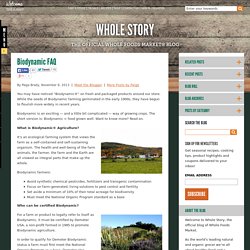
While the seeds of Biodynamic farming germinated in the early 1900s, they have begun to flourish more widely in recent years. Biodynamic is an exciting — and a little bit complicated — way of growing crops. The short version is: Biodynamic = food grown well. Want to know more? Read on. An Herb Planting Guide from The Growers Exchange. Mass Spectrum Botanicals - Tampa, Florida. Welcome to APS. Gardens Delight. Tending Produce. Cannabis Cultivarsity. Agros Technica. Water in situ. National Arboretum - USDA Plant Hardiness Zone Map. Wednesday, April 16, 2014 Back to the Arboretum Home Page Arboretum Information || Events & Education || Gardens & Horticulture || Research ActivitiesNew Plant Introductions || Support the Arboretum || Comments.

Garden Tower Project - Planting Schedule & Hardiness Zones. If there's one thing that every gardener learns, -- timing is everything.
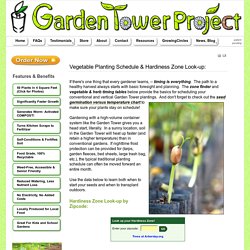
The path to a healthy harvest always starts with basic foresight and planning. The zone finder and vegetable & herb timing tables below provide the basics for scheduling your conventional and vertical Garden Tower plantings. Pots That Self-Water When You're Away. The biggest problem with a container garden is that it often requires daily watering.
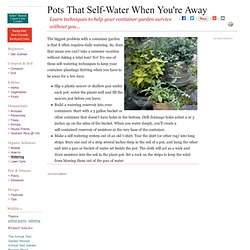
So, does that mean you can't take a summer vacation without risking a total loss? No! Try one of these self-watering techniques to keep your container plantings thriving when you have to be away for a few days. Slip a plastic saucer or shallow pan under each pot; water the plants well and fill the saucers just before you leave. Using Molasses To Boost Fertilizer. Molasses added to your organic fertilizers feeds the healthy microbes in the soil, mulch and on the plant leaves.
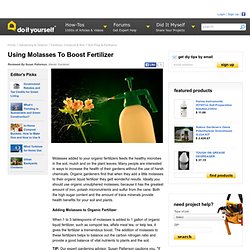
Many people are interested in ways to increase the health of their gardens without the use of harsh chemicals. Organic gardeners find that when they add a little molasses to their organic liquid fertilizer they gett wonderful results. Ideally you should use organic unsulphered molasses, because it has the greatest amount of iron, potash micronutrients and sulfur from the cane. Ways to use Hydrogen Peroxide in the Garden. The benefits of hydrogen peroxide for a garden can be useful for any kind of a garden, and any method of gardening.
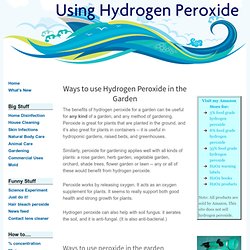
Peroxide is great for plants that are planted in the ground, and it’s also great for plants in containers -- it is useful in hydroponic gardens, raised beds, and greenhouses. Similarly, peroxide for gardening applies well with all kinds of plants: a rose garden, herb garden, vegetable garden, orchard, shade trees, flower garden or lawn -- any or all of these would benefit from hydrogen peroxide. Peroxide works by releasing oxygen. It acts as an oxygen supplement for plants. Companion Planting - Secrets of Organic Gardening. Three Sisters Garden: Corn, Beans, Squash - A Native American tradition. Early European settlers would certainly never have survived without the gift of the Three Sisters from the Native Americans, the story behind our Thanksgiving celebration.
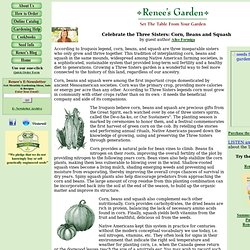
Celebrating the importance of these gifts, not only to the Pilgrims but also to civilizations around the globe that readily adopted these New World crops, adds meaning to modern garden practices Success with a Three Sisters garden involves careful attention to timing, seed spacing, and varieties. In many areas, if you simply plant all three in the same hole at the same time, the result will be a snarl of vines in which the corn gets overwhelmed!
Cornell Garden-Based Learning. The Three Sisters | A Legend | Diversity | Sister Corn | How to Plant the Three Sisters | Exploring Corn | Activities | Information | Evaluation Experience an Iroquois Garden In this section you will learn how to plant the Three Sisters according to Iroquois custom.
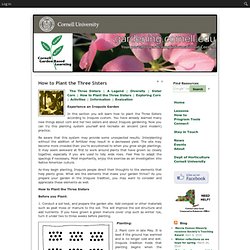
You have already learned many new things about corn and her two sisters and about Iroquois gardening. Now you can try this planting system yourself and recreate an ancient (and modern) practice. Be aware that this system may provide some unexpected results. As they begin planting, Iroquois people direct their thoughts to the elements that help plants grow. How to Plant the Three Sisters Before you Plant: 1. Planting: 2. Soak corn seeds for several hours, but not more than eight hours, before planting. Lasagna Gardening 101. How To Plant & Grow Bulbs, Corms & Tubers. Planting bulbs, corms and tubers is an easy way to ensure colourful displays in your garden, particularly in spring before the rest of the garden has woken from its winter dormancy.
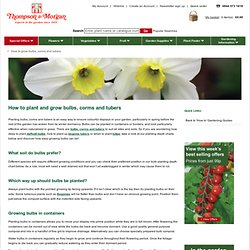
Bulbs can be planted in containers or borders, and look particularly effective when naturalised in grass. There are bulbs, corms and tubers to suit all sites and soils. So if you are wondering how deep to plant daffodil bulbs, how to plant up begonia tubers or when to plant tulips, take a look at our planting depth charts below and discover how easy growing bulbs can be!
What soil do bulbs prefer? Different species will require different growing conditions and you can check their preferred position in our bulb planting depth chart below. Which way up should bulbs be planted? Always plant bulbs with the pointed growing tip facing upwards. Food Gardening Guide. Dealing with Common Vegetable Diseases. Edible Garden Consultation and Design. Growing and caring for Bonsai trees - Bonsai Empire. Kuromatsubonsai.com. Bonsai On The Web. Propagating Plants By Grafting. [Continued From January Number.] By A. 8. Fuller. Roots are often used for stocks instead of the stems of plants.
![Propagating Plants By Grafting. [Continued From January Number.] By A. 8. Fuller](http://cdn.pearltrees.com/s/pic/th/propagating-grafting-continued-81429611)
Cions may be fitted to a root, or a section of one, in precisely the same manner as they are upon stems or branches. The mechanical part of the operation is very similar in both cases. Sometimes it is desirable to graft below the surface of the soil, that the cion may eventually take root and become capable of furnishing itself with sustenance from the earth instead of relying upon the original stock. In all cases where it is expected that the cions will emit roots, the junction should be made below the surface of the soil, at least so low that only the uppermost one on the cion shall be above the surface. Fig. 25 shows a common method of crown grafting below ground. Budding. Graft of majorcan escutcheon: Grafting and Budding Nursery Crop Plants. Contents Introduction Grafting Budding SummaryAppendix Grafting and Budding Nursery Crop Plants Introduction Grafting and budding are horticultural techniques used to join parts from two or more plants so that they appear to grow as a single plant.
Grafting. Grafting When to Graft Unlike budding, which can be performed before or during the growing season, most grafting is done during winter and early spring while both scion and rootstock are still dormant. Containerized plants may be moved indoors during the actual grafting process; after grafting, these plants are placed in protected areas or in unheated overwintering houses.
Field-grown stock, of course, must be grafted in place. Some deciduous trees are commonly grafted as bare rootstock during the winter and stored until spring planting. Plant Propagation by Stem Cuttings: Instructions for the Home Gardener. Propagation of Plants by Stem Cuttings - Rainyside.com. When we first become gardeners we rush out in spring to buy annuals in six packs and start a few seeds in the ground.
As we become more knowledgeable, we venture out and start planting perennials, shrubs and vines. Our pocketbooks become lean from the expense of buying plants from the nurseries so we start to wonder how we can save money and still have a beautiful garden. One inexpensive way to obtain new plants is by taking cuttings. Many of us have successfully started new plants by rooting houseplant stems in water on our kitchen windowsill. G6970 Home Propagation of Garden and Landscape Plants.
Guide to Growing Rice. How to Grow Poppies, Poppy Plants, Seed by Garden Hobbies. A Taste of Gardening. Backyard Gardener, Your Gardening Source with Gardening Tips. Tips and Advice on Outdoor Gardening, Flower Gardens, Plants, & Seeds - Dave's Garden. Marijuana, medicinal herbs and the moon. ICAAP. Internationally Recognized 72 Hour Permaculture Design Certification Course. Welcome to APSnet.